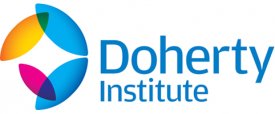13 Aug 2018
From Bush to Bench
WHO Collaborating Centre for Viral Hepatitis epidemiologist, Nicole Romero shares her insights of the Doherty Institute’s From Bush to Bench Forum. An event to mark International Day of the World’s Indigenous Peoples and World Hepatitis Day.
Associate Professor Steven Tong opens From Bush to Bench.
From Bush to Bench was filled with rich discussions on a wide spectrum of viral hepatitis and Indigenous health topics. The morning session focussed on viral hepatitis, highlighting the great amount of work that has been done in the sector, both in Australia and across the world, as well as areas of focus for the future.
The day began with a great talk and Q&A session with community speaker Moira Burke, a woman who lived with hepatitis C for 35 years and was recently cured. As researchers, we often forget to think about the individual and how living with a chronic disease such as hepatitis B and C affects their lives and interactions with others.
It was fantastic to get this perspective and frame everyone’s thinking for the rest of the sessions. After hearing about the positive personal gain of hepatitis C cure on an individual level, we then heard of the cost-effectiveness and cost-saving benefits of a possible hepatitis B cure, currently still a theoretical idea.
Dr Mehlika Toy, visiting from Stanford University, presented the mathematical model she has developed in collaboration with WHO Collaborating Centre for Viral Hepatitis here at the Institute, which shows that in 20 years, a hepatitis B cure would reduce the incidence of liver cancer by 90 per cent and related deaths by 80 per cent.
Further sessions focused on the current epidemiology of hepatitis B and C in Australia and how we are tracking in reaching elimination targets. Jennifer MacLachlan, Doherty Institute epidemiologist presented data from the Viral Hepatitis Mapping Report, which showed disparities in prevalence, care and treatment uptake across different geographic areas in Australia.
Her presentation really highlighted areas of priority for Australia, including the need to increase treatment access and uptake, particularly in rural areas.
Professor Joe Torresi, head of one of the Institute’s hepatitis laboratories, made some very interesting points about how Australia is only treating the tip of the iceberg when it comes to hepatitis C, and why a hepatitis C vaccine is still necessary, despite the availability of effective curative treatments.
Both really interesting presentations that gave listeners a lot to think about as Australia moves towards elimination of viral hepatitis.
It was also fantastic to hear the experiences and learnings from current programs aimed to reduce the burden of viral hepatitis, both in an Australian context and internationally.
We heard from Oyuntuya Bayanjargal from Mongolia, who discussed their Healthy Liver Program and the amazing progress they have made to ensure people living with viral hepatitis are diagnosed, enrolled in care and treated.
We also heard from the Institute’s Associate Professor Steven Tong and Dr Margaret Littlejohn about the amazing work they have been doing in the Northern Territory in collaboration with the Menzies School of Health Research.
Considering the remoteness of the communities they are working with, they have made great strides in educating and providing care and treatment for Indigenous communities, in a culturally appropriate way. It’s important to learn from programs and initiatives such as these, and apply teachings into the work being done across Australia.
Epidemiologist with the Doherty Institute’s Indigenous Health group, Dr Kyle Turner shares his thoughts on the Indigenous health session of From Bush to Bench.
Local Wurundjuri Elder, Georgina Nicholson, was kind enough to open the From Bush To Bench Indigenous health talks with a warm Welcome to Country.
The room was now at its fullest, with a dozen or so left standing up the back. I had been to countless Indigenous conferences, community events and activities, which at times can leave you with a sense of pessimism – but this was a celebration (in comparison to some of those).
There was genuine excitement coming from the speakers and audience members about the future of Indigenous health—I recall Professor Sandra Eades remarking on the same feeling during her closing panel discussion (although she was perhaps still glowing from her trip to Garma).
Of all the amazing talks on the day, I would have awarded the prize for ‘most interesting research’ to Dr Margaret Littlejohn (surely, I was not the only one googling ‘archaeovirology’). Margaret had dated the origins of hepatitis B virus (HBV) genotype C4 (a genotype entirely unique to northern Aboriginal peoples) and used it to infer ancient human population movements. Fascinating research that had the audience hooked.
I also enjoyed how Dr Misty Jenkins, Deputy Chair of the National Centre for Indigenous Genomics (NCIG), challenged the audience to engage further in genetics research with Indigenous Australians—I particularly enjoyed the empty ‘too hard’ basket on her first slide. I know that many people asked Misty later about the powerful explainer video she showed from the NCIG – be sure to check it out if you haven’t already – which is a wonderful example of science communication.
Finally, the biggest highlight for the day was certainly hearing from George Garambaka Gurruwiwi, Roslyn Gundjirryiir Dhurrkay, and Sarah Mariyalawuy Bukulatjpi from Galiwin’ku in East Arnhem Land. Health practitioners with the Menzies School for many years, the inspiring trio stressed the importance of allowing time for community members to come around to HBV (and other) screening. Video was again shown to be a powerful resource, with George, Roslyn and Sarah sharing their HBV stories using local language and scenery.
Professor Sandra Eades, Professor Sharon Lewin and Dr Misty Jenkins hold a panel discussion about the direction of the Doherty Institute regarding Indigenous Health.

